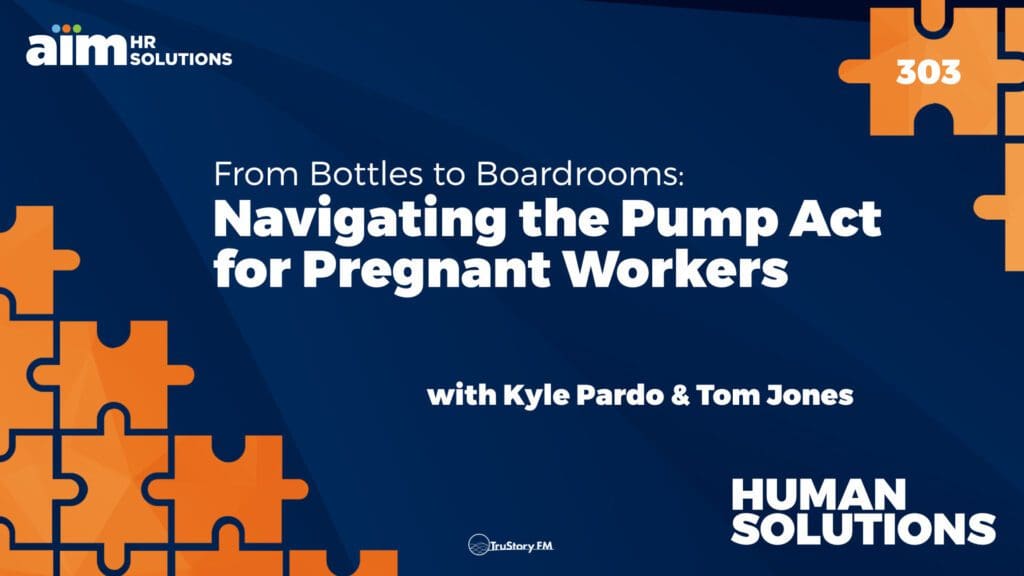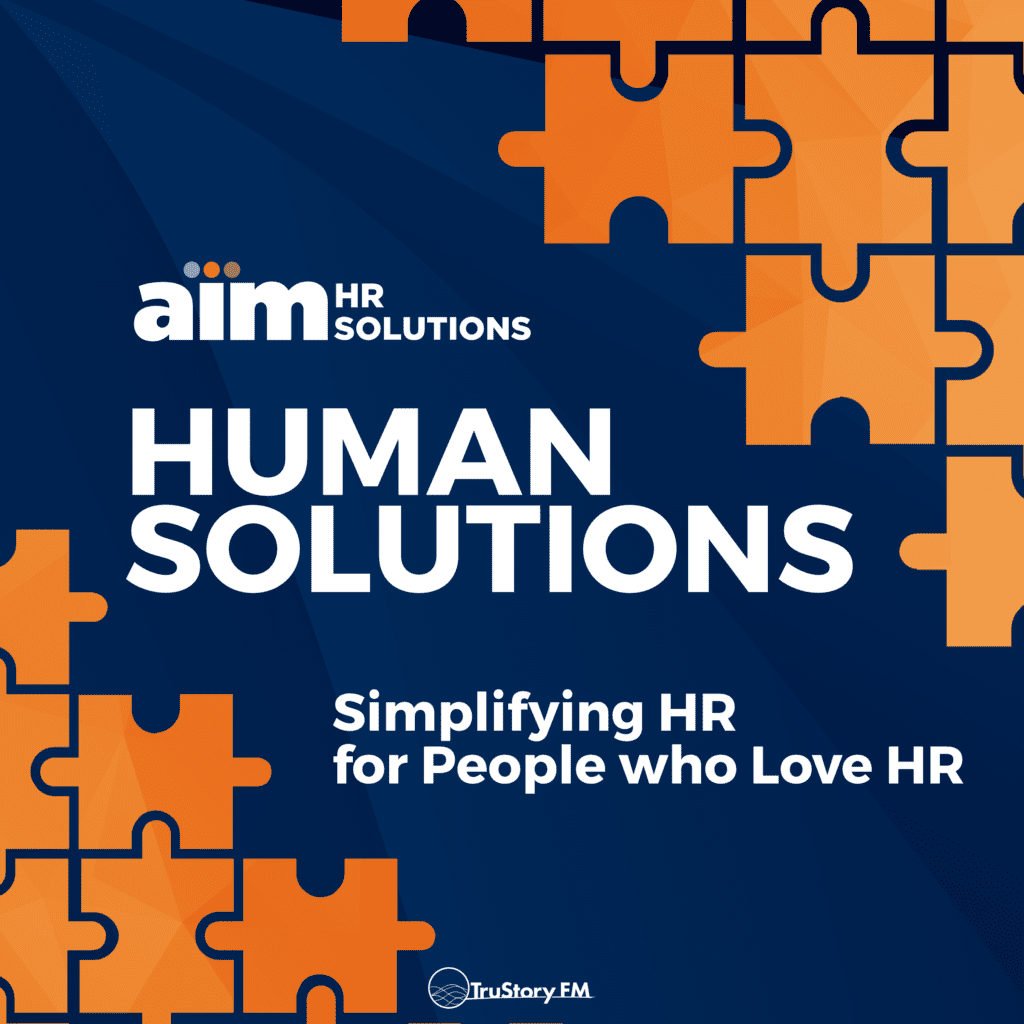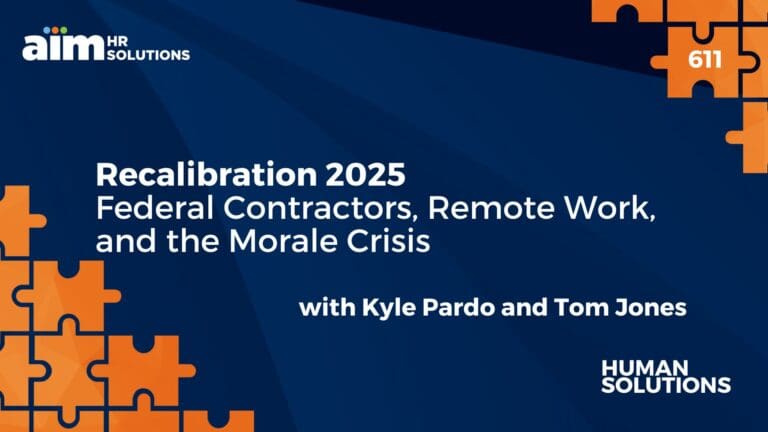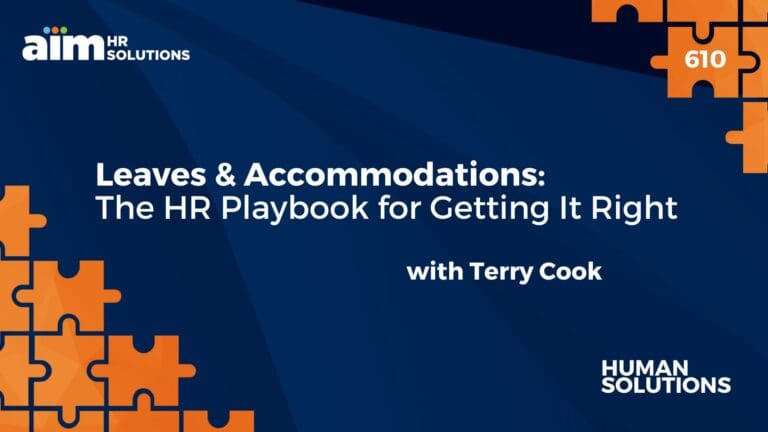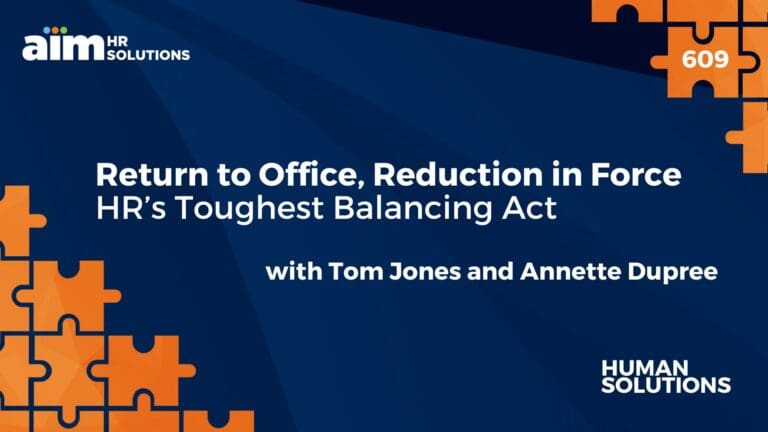Are you a working parent expecting a baby? Or are you an HR professional looking to support pregnant and nursing employees? Regardless, you’ll want to tune in to this episode of Human Solutions. Pete Wright hosts experts Kyle Pardo and Tom Jones from AIM HR Solutions as they discuss everything from legal requirements for employers to mental health support for pregnant workers.
We’ll explore the PUMP Act, a new law expanding the 2010 break time law for nursing mothers in the workplace. We’ll navigate the ins and outs of the legislation and learn how HR professionals can ensure they stay up to date on relevant laws and regulations related to pregnancy and the workplace. But we won’t stop there. We’ll also explore pregnancy discrimination and the Family and Medical Leave Act (FMLA).
Whether you’re a working parent, an HR professional, or just curious about this important topic, you won’t want to miss this episode.
Links & Notes
- FLSA Protections to Pump At Work
- Fact Sheet #73: FLSA Protections for Employees to Pump Breast Milk at Work
- MCAD Guidance on the Pregnant Workers Fairness Act
- What You Should Know about the Pregnant Workers Fairness Act
- What to Expect When You’re Expecting (and After the Birth of Your Child)…at Work
- The PUMP for Nursing Mothers Act: What You Should Know
Episode Transcript
Pete Wright:
Welcome to Human Solutions, simplifying HR for people who love HR. From AIM HR Solutions on True Story FM, I’m Pete Wright. Are you a working parent, expecting a baby, or are you an HR professional looking to support pregnant and nursing employees? Whoever you are, this is the episode for you. Today we’ve got experts Kyle Pardo and Tom Jones here to talk about the PUMP Act and all of the various regulations and legal issues and opportunities that stem from having new moms at work. Kyle Pardo, Tom Jones, it’s good to see you both.
Kyle Pardo:
Nice to see you.
Tom Jones:
Good to see you. Thank you for having us back.
Pete Wright:
We are talking about the PUMP Act today. Tell me, what do I need to know about the PUMP Act? How does it change things in Massachusetts? And what do we have to look forward to? Tom, do you want to start?
Tom Jones:
Sure. The PUMP Act is recently signed by President Biden, so it’s actually a national law, not just a state level, so it’s going to affect the whole country. It was signed right before New Year’s, that week between Christmas and New Year’s, by the president, and a whole bunch of legislation. But this is one of the key laws that got signed. It’s going to require employers to make an accommodation for employees who are nursing in the workplace, who need time off during the workday, some time out of the work schedule in order to be able to express milk. There’s a whole bunch of rules associated with that. Some of it is a continuation of what was passed in 2010 as part of the Affordable Care Act, but this is a broadening of that law. So now it’s going to cover just about every working woman who it possibly could, because it now covers exempt employees, not just non-exempt employees.
Pete Wright:
Okay. So practically, what does this mean for working mothers? Kyle, do you want to talk about it from an HR perspective? What do we need to be considerate of at work?
Kyle Pardo:
Sure. So there’s a couple of things to think about. One is to make sure you have a space in your company that a woman could go to use to pump during the workday. So that might be in office that doesn’t have any windows facing out to the company. It could be a small conference room that could be reserved, some space aside from a bathroom, so it cannot be a restroom, that a woman could go to use to pump. The location would need to have a lock on the door and really be viewed as a separate space.
The second thing is giving women break time, so giving them time during the day to go do this. And the word used is reasonable. So there’s not a set amount of time on that. But people should be considering that break time in Massachusetts, if it’s less than 20 minutes, it’s a paid break. So the same would apply here. The female employee should be relieved from work responsibilities during that break period.
And then the other thing to think about is that this law applies, as Tom said, to all employers. But if the company has less than 50 EM employees, there may be some undue hardships that they could come up against. And if that was the case, you should really think about, is it a place where there really is no opportunity to have a separate office or separate location or something like that, that would really create an undue hardship for that small company?
Pete Wright:
Just a quick question about the breaks. You mentioned both regular breaks that fall into sort of paid 20 minutes’ time to take a break. Is the lactation break a separate break time in addition to regular breaks or can employers just count a lactation break as the break?
Tom Jones:
Well, picking up where Kyle just made the point, it’s hard to know how many times a day a woman may need to express milk, and a new mother may need more time than a mother who’s been longer from the birth. So it’s hard to know for sure the demand of people’s time. But each break, the company can say, “We have a morning break, afternoon break, like a coffee break.” But the reality is, for expressing milk, there may be more demands for the woman to have a break. So as long as they’re 20 minutes or less, those are paid breaks for non-exempt employees. For exempt employees, they’re going to be paid breaks anyway.
And the other thing to keep in mind is for a non-exempt employee, let’s say somebody who covers the phones, she can do so from inside an office, and she does so while she’s expressing milk. That’s work time. That’s not a break time. So she can’t be charged for break time. And if a break goes over 20 minutes, she can’t be not paid, but she’s working that whole time. So if you’re working, you’re working.
Pete Wright:
Okay. Working while expressing milk, is that what you just said?
Tom Jones:
Some people do, which there are cases, some people are doing that.
Pete Wright:
If their office is private and they’re able to close the door and continue to work while expressing milk, that’s not counted as a break.
Tom Jones:
Right.
Kyle Pardo:
True multitasking, Pete.
Pete Wright:
Kyle, my mind is exploding with the complexities. As a dad, I remember the halcyon days of the newborns. That was not an uncomplicated experience for my wife to figure out how to navigate this. And so I wonder where the limitations are of the PUMP Act and the impact on mothers and on the workplace. How long after the child is born do they have to wrangle this particular complication? Do they have until the kid’s five, or how long does it last?
Tom Jones:
By law, it’s for one year.
Pete Wright:
One year, okay.
Tom Jones:
One year from the birth. That’s this federal law. Massachusetts has a law called Pregnant Workers Fairness Act, which is very similar in its function. And that does not have a timetable. So in theory, it could be beyond one year if the mother were choosing to express milk a longer period of time, or if she were dealing with other medical or emotional issues related to her birth, like postpartum or things like that, there is no cap in Massachusetts. There is under the federal law, of one year for the expressing milk, but under state law … So that means for an employer who operates in multiple states, they want to make sure they know the state law.
Kyle Pardo:
Tom just made an interesting point in talking about the Pregnant Workers Fairness Act. So we’re jumping over a little bit here, but that’s a broader law that’s been around in Massachusetts since 2018 and has just become a federal law and becoming effective later this year in June, I believe it is. Is that right, Tom? And that one really encourages employers to think a little bit more broadly. So it’s not just about pumping and having a place to pump, but it’s including things like accommodations for women who are pregnant or have just given birth.
And so it might be that the employee needs more frequent breaks, as we talked about. Those might be restroom breaks associated with pregnancy. It could be the need to sit down more frequently on the job. It could be things like not lifting … while it’s always been a job requirement, that that may need to go away during the period of pregnancy or just after. And it could even be something like parking and where the employee parks. So if a pregnant employee comes to UN HR and says, “I’m going to be giving birth,” that’s your notice as an employer that, “Okay, here’s some things I need to now think about and be aware of and make sure that my employee knows about having a discussion about any of these accommodations or learning about what our resources are in the office for pumping after the birth,” but really starting that process as soon as that employee comes to you.
Pete Wright:
Can we talk about how these two sets of regulation, the overlapping sets of regulation, overlap once again with FMLA? Are there other knots we need to untangle?
Tom Jones:
Well, different states have different leaves of absent laws apart from the FMLA. So the FMLA is the federal law. And that would certainly say that among the various things, it would be a serious medical condition. I mean, typically, FMLA breaks down two ways. There’s a family leave component, which is generally associated with post-birth or maybe a couple weeks up to leading to the birth and time off for work. And there’s a medical component, which could be for difficult pregnancy, some of the issues Kyle may have alluded to, a woman struggling over being able to get to work on time, being able to do different things. So it could potentially trigger rights under the FMLA A or under a state leave of absence law. Massachusetts has a family and medical leave law, which is paid, as do a number of other states. And so the potential exists for a woman to seek benefits under that law as well that would provide some protection, job-protected leave if necessary.
Pete Wright:
Kyle, you mentioned the notice that you get as an HR professional. When somebody comes to you and says, “I’m giving birth,” that’s your notice. What are the areas that might define or let’s say the corners around which we must peek that could get us in trouble, from an HR perspective?
Kyle Pardo:
The situation just came up the other day, and it’s very interesting, which is a company that just hired a new employee and found out that the employee was five months pregnant when they were hired. And so they’ve brought this employee on obviously knowing that they have this need in their company. And now we’re thinking, “This person’s now going to be out in a couple of months. They’re going to be out of maternity leave.” And so their first in thought is probably, “How are we going to get their work done? How’s this going to impact our business?” But truthfully, that’s something that should alert employees to say, “Okay, we can’t change anything here. We can’t go back and take back our offer. We can’t do anything that’s going to be an employment action that will discriminate against this employee due to pregnancy or pregnancy-related condition.” So that’s the first thing, is always to think about, is the decision that I’m making going against this person because they’re pregnant or something associated with postpartum or another need? So yeah, that can happen very easily in the workplace if these situations come up.
Tom Jones:
Just to build on that a minute, the new PUMP law has very significant penalties associated with it for failure to comply. Basically, what the law says is if a woman believes that the company’s not complying, they’re supposed to give the company 10 days’ notice. And the 10 days’ notice, it’s designed to remedy that period. So if a female employee came to the company and said, “We don’t have a place to express milk,” you give the company 10 days to fix that. That’s a considered a reasonable period of time for the company to be on notice and say, “Okay, we’ve got it now, a dedicated space.”
And it could be temporary. It’s not like you have to create a permanent room. It could be a temporary space that as long as you’ve got lights and security and privacy, will meet the test. But otherwise, an employee could sue for wages, for unpaid wages, they could sue for other damages that the company could pay quite a bit for it. Not only that, but I think it’s a cultural issue. If a company doesn’t respond well to an employee seeking a reasonable benefit like this protected under law, the message to other employees may be devastating.
Pete Wright:
Sure. It’s interesting to me that this issue is starting to bubble up in popular culture. We were just watching an episode of a television show where an employee took a job and actually gave birth the day she started the job. But the underlying storyline was, “I was terrified. I need work. And I thought, ‘I can’t tell, because they will discriminate against me.'” And yet here we are. The PUMP Act is now in place. Now you said it was just signed before the new year. When does it actually take action? Is it in place now?
Tom Jones:
Took effect already. The one thing that isn’t in place yet, it comes in April 23rd, I believe it is, are the penalties, but the actual law … So if an employee came to you now and said, “I need a place under the PUMP Act to be protected for expressing milk,” the company should respond to that immediately and comply with the law. Come April, end of April, they could be sued and pay significant damages for failure to comply.
Pete Wright:
Kyle, you mentioned the cultural issues, right? You’re an HR manager at our favorite fictitious manufacturing organization. And we’re growing and everything’s great, but we’ve never had a lactating mother in our offices. How do you go about teaching, educating culturally that there are some things we need to think of differently when it comes to the people who work with us?
Kyle Pardo:
Yeah. There’s a lot that goes into it. And it’s interesting that you use our fictional manufacturing company, because it could be an environment that’s used to having many male employees. And so this situation may not have come up before. Other companies, it may be a very frequent occurrence, so they should really be thinking about it. The best thing to do, as anything, is be proactive. Think about it now before you have an employee in this situation. So looking at your company right now and saying, “Okay, if an employee came to me today and said that they need a space to pump, what would we use? Do we have an office? Do we have a conference room? Do we have some area that can be closed off?” And really identifying that before an employee comes.
Pete Wright:
That can be permanent, right, single-use space?
Kyle Pardo:
Yes. And again, it could be something like a storage closet, which sounds undesirable, but making it a little bit more desirable, so cleaning it out, making sure there’s a chair in there, making sure there’s light in there, that type of thing. So it might take some [inaudible 00:14:18]-
Pete Wright:
Yeah, and a lot of Windex, like so much cleaning supply. But as long as there’s some pillows, it’ll be [inaudible 00:14:24]-
Kyle Pardo:
Yeah. So it might take some creativity, depending on how your company is set up. So that’s the first thing. The second thing is making sure you have your notices ready. So with the Pregnant Workers Fairness Act, there is a notice that should be given to employees, so it should be in your employee handbook, letting employees know that the company’s aware of this law and will not discriminate against employees if they’re pregnant. So that notice also needs to be given out to employees when they come to you and tell you that they’re pregnant. So again, proactively having that ready. And then the third one would just be to encourage supervisors to be creative and think about it. You can think of a situation where somebody at our manufacturing company might be working on machinery and they have to stand all day. So is there an opportunity there to have a stool in place or something where the employee could sit down if necessary? So something like that would be considered a reasonable accommodation.
Pete Wright:
Fascinating, and fantastic for new and working mothers to have this opportunity to potentially put some of the stigma around having a child behind us and being able to continue to earn a living. Thank you both for sitting down with me and educating me and the rest of us. Now, I’ve got a list of fantastic links in the show notes, links to what the PUMP Act is about, the FMLA implications of it, and the FLSA protections. So please swipe up in the show notes and take a look at it if you were listening there and you want some links to take to your HR manager and help start that conversation. Tom Jones and Kyle Pardo, thank you so, so much for being here.
Kyle Pardo:
Thank you, Pete. Take care.
Tom Jones:
You’re welcome. Thanks, Pete.
Pete Wright:
And thank you, everybody, for downloading and listening to this show. We sure appreciate your time and attention. You can find all of the links and notes on the website or in your show notes. On behalf of Tom Jones and Kyle Pardo, I’m Pete Wright. We’ll see you next week right here on Human Solutions, simplifying HR for people who love HR.







